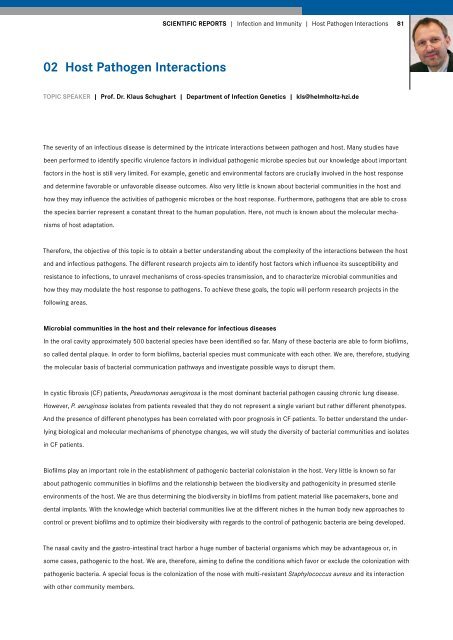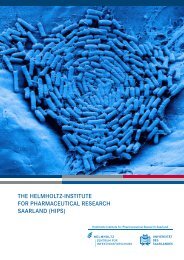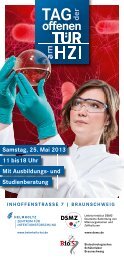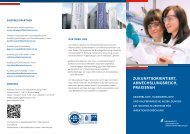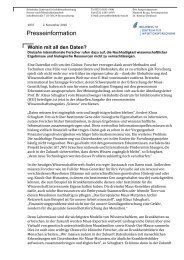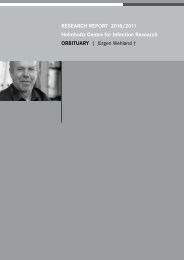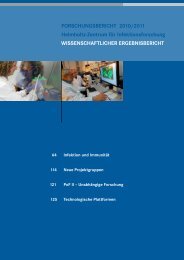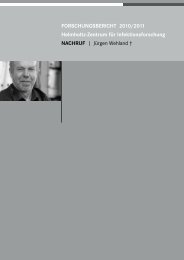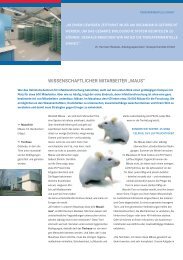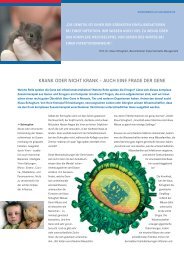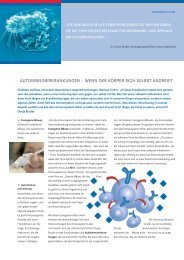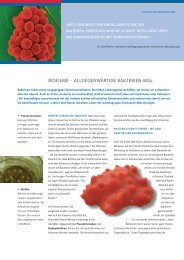Research Report 2010 2011 - Helmholtz-Zentrum für ...
Research Report 2010 2011 - Helmholtz-Zentrum für ...
Research Report 2010 2011 - Helmholtz-Zentrum für ...
Create successful ePaper yourself
Turn your PDF publications into a flip-book with our unique Google optimized e-Paper software.
SCIENTIFIC REPORTS | Infection and Immunity | Host Pathogen Interactions<br />
81<br />
02 Host Pathogen Interactions<br />
TOPIC SPEAKER | Prof. Dr. Klaus Schughart | Department of Infection Genetics | kls@helmholtz-hzi.de<br />
The severity of an infectious disease is determined by the intricate interactions between pathogen and host. Many studies have<br />
been performed to identify specifi c virulence factors in individual pathogenic microbe species but our knowledge about important<br />
factors in the host is still very limited. For example, genetic and environmental factors are crucially involved in the host response<br />
and determine favorable or unfavorable disease outcomes. Also very little is known about bacterial communities in the host and<br />
how they may infl uence the activities of pathogenic microbes or the host response. Furthermore, pathogens that are able to cross<br />
the species barrier represent a constant threat to the human population. Here, not much is known about the molecular mechanisms<br />
of host adaptation.<br />
Therefore, the objective of this topic is to obtain a better understanding about the complexity of the interactions between the host<br />
and and infectious pathogens. The different research projects aim to identify host factors which infl uence its susceptibility and<br />
resistance to infections, to unravel mechanisms of cross-species transmission, and to characterize microbial communities and<br />
how they may modulate the host response to pathogens. To achieve these goals, the topic will perform research projects in the<br />
following areas.<br />
Microbial communities in the host and their relevance for infectious diseases<br />
In the oral cavity approximately 500 bacterial species have been identifi ed so far. Many of these bacteria are able to form biofi l m s ,<br />
so called dental plaque. In order to form biofi lms, bacterial species must communicate with each other. We are, therefore, studying<br />
the molecular basis of bacterial communication pathways and investigate possible ways to disrupt them.<br />
In cystic fi brosis (CF) patients, Pseudomonas aeruginosa is the most dominant bacterial pathogen causing chronic lung disease.<br />
However, P. aeruginosa isolates from patients revealed that they do not represent a single variant but rather different phenotypes.<br />
And the presence of different phenotypes has been correlated with poor prognosis in CF patients. To better understand the underlying<br />
biological and molecular mechanisms of phenotype changes, we will study the diversity of bacterial communities and isolates<br />
in CF patients.<br />
Biofi lms play an important role in the establishment of pathogenic bacterial colonistaion in the host. Very little is known so far<br />
about pathogenic communities in biofi lms and the relationship between the biodiversity and pathogenicity in presumed sterile<br />
environments of the host. We are thus determining the biodiversity in biofi lms from patient material like pacemakers, bone and<br />
dental implants. With the knowledge which bacterial communities live at the different niches in the human body new approaches to<br />
control or prevent biofilms and to optimize their biodiversity with regards to the control of pathogenic bacteria are being developed.<br />
The nasal cavity and the gastro-intestinal tract harbor a huge number of bacterial organisms which may be advantageous or, in<br />
some cases, pathogenic to the host. We are, therefore, aiming to defi ne the conditions which favor or exclude the colonization with<br />
pathogenic bacteria. A special focus is the colonization of the nose with multi-resistant Staphylococcus aureus and its interaction<br />
with other community members.


